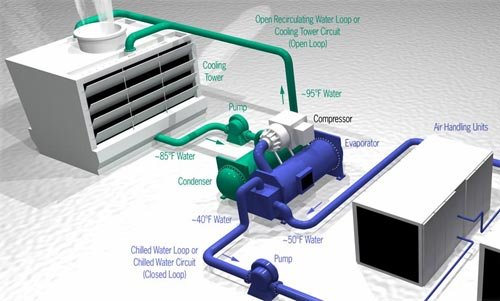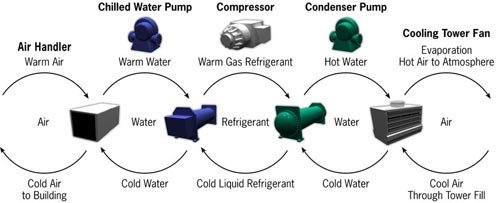Chiller Basic
Last updated: 18 ก.พ. 2556 | 10359 จำนวนผู้เข้าชม |

Chiller Basics
What is a Chiller?
A chiller is a water-cooled air conditioning system that cools inside air, creating a more comfortable
and productive environment. Chillers are also used in the manufacturing environment to provide
"process" cooling to equipment in an effort to maximize productivity.With large facilities, such as
commercial buildings, hospitals, universities, government facilities and theme parks, the cost of
energy to generate cooling in excess of 50 tons is cost prohibitive with air-cooled units. Water-cooled
chillers produce higher tonnage at lower costs per ton, creating greater energy efficiency. A typical
home has 3-5 tons of cooling capacity.
and productive environment. Chillers are also used in the manufacturing environment to provide
"process" cooling to equipment in an effort to maximize productivity.With large facilities, such as
commercial buildings, hospitals, universities, government facilities and theme parks, the cost of
energy to generate cooling in excess of 50 tons is cost prohibitive with air-cooled units. Water-cooled
chillers produce higher tonnage at lower costs per ton, creating greater energy efficiency. A typical
home has 3-5 tons of cooling capacity.

How a Complete Chiller System Works
Chillers circulate chilled water to air-handlers in order to transfer heat from air to water. This water
then returns to the evaporator side of the chiller where the heat is passed from the water to a liquid
refrigerant (freon).The refrigerant leaves the evaporator as a cold vapor and enters the compressor
where it is compressed into a hot vapor. Upon leaving the compressor, the vapor enters the condenser
side of the chiller where heat is transferred from the refrigerant to the water side of the condenser
where it is circulated to an open cooling tower for the final removal of heat via evaporation in the
cooling tower.
then returns to the evaporator side of the chiller where the heat is passed from the water to a liquid
refrigerant (freon).The refrigerant leaves the evaporator as a cold vapor and enters the compressor
where it is compressed into a hot vapor. Upon leaving the compressor, the vapor enters the condenser
side of the chiller where heat is transferred from the refrigerant to the water side of the condenser
where it is circulated to an open cooling tower for the final removal of heat via evaporation in the
cooling tower.
What is Chiller Efficiency?
Chiller efficiency is the amount of energy (electricity) it takes to produce a "ton" of cooling. It is
expressed as kw/ton. All chillers have a designed kw/ton efficiency that was established when the
chiller was commissioned. Plant design, water treatment, maintenance practices, chiller age,
cooling tower design, cooling load and plant operations dramatically effect chiller operating
efficiency and operating costs.
expressed as kw/ton. All chillers have a designed kw/ton efficiency that was established when the
chiller was commissioned. Plant design, water treatment, maintenance practices, chiller age,
cooling tower design, cooling load and plant operations dramatically effect chiller operating
efficiency and operating costs.

เนื้อหาที่เกี่ยวข้อง
Basic Air Conditioner System
7 ก.พ. 2556
Powered by
MakeWebEasy.com
